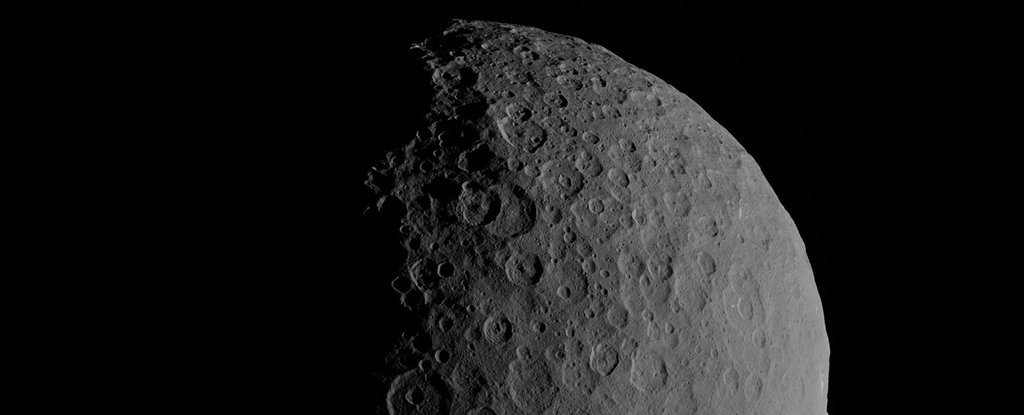
A scientist said that having a “giant satellite” orbiting Ceres would make a good home for humans
Given all of the logistics involved, it is unlikely that humanity will see our way outside of the solar system to colonize exoplanets. But the possibility of stability elsewhere in the solar system is not far-fetched.
NASA plans to build a site on the moon. Crew missions to Mars not far. Heck, we already have humans living outside the planet (albeit for temporary periods) on the International Space Station.
So, is there anywhere else in the solar system that humans could make our home? Well, according to physicist and astrobiologist Pekka Janhunen of the Finnish Meteorological Institute in Finland, the dwarf planet Ceres isn’t completely implausible.
Ceres is an interesting piece of rock. It hangs in asteroid A belt between Mars and Jupiter, with a diameter of 952 kilometers (592 miles), is the largest known asteroid in the solar system, and the only dwarf planet closer to the sun than Neptune.
Why Ceres? Janhunen thinks he’s ticking too many coveted funds.
“Motivation,” he wrote in a preprint paper published on arXiv, “Is to have a settlement with an artificial attractiveness that allows growth outside the living area on land, while providing ease of travel within settlements for residents and a reasonably low population density of 500 [people per] Square kilometers.”
He also argues that Mars and the Moon may not be the best places for human colonies, because their natural attraction is so different from Earth’s. We know that astronauts face health problems when they return to Earth from a low or no-gravity environment; We have very little idea about the effects of growing to maturity in low gravity.
An alternative to the planetary colony model is an artificial space colony orbiting the Sun – a space station that orbits to generate enough centrifugal force to mimic One g: Gravity.
That would be terrible logistically, too. If the population increases too large for a single settlement, then multiple settlements may be required. If there are multiple colonies in orbit around the sun, they may be diverged from each other, creating other problems, such as travel between settlements. If they are orbiting a common object, collision avoidance becomes a problem.
Janhunen’s solution is quite neat, really, at least in terms of concept: Use Ceres as a base around which knots can spin yarn leveling, attached to a fixed frame.
Not only will this solve the problem of keeping the settlement nodes together without the possibility of collision, but it will also solve the problem of materials with precision, as they can be collected directly from the dwarf planet. Janon said nitrogen is especially important, as it makes up much of the Earth’s atmosphere.
But we also know that Ceres is very salty, and recent research indicates that it may also contain a lot of water below the surface. Solar panels on the surface of the dwarf planet could easily operate a space elevator for a satellite.
“Lifting materials from Ceres is energy-efficient compared to treating and converting them into habitats, if a space elevator is used,” said Janhonen. He explains. “Since Ceres has low gravity and spins relatively quickly, a space elevator is possible.”
He said radiation protection can be built from 80 percent of silicate regolith (a rock from Ceres) and water. The habitats will be divided into rural and urban areas with a depth of 1.5 to 4 meters, as needed for trees and gardens.
(P. Janhunen, arXiv, 2020)
Since Ceres is so far from the sun, mirrors can be used to direct sunlight towards the habitat, for the purpose of growing crops, lighting and solar energy. These mirrors would be hung on one side of the satellite in the shape of a disk, like a compact make-up, and could be adjusted to collect most of the sunlight as the dwarf planet moved around the sun.
“We are using the disk geometry of the massive satellite because its symmetry cancels out the tidal torque so that reaction wheels are not needed to maintain the position,” Janhonen said. Writes.
“Habitats are illuminated by natural sunlight. Sunlight is gathered on the disk by two flat mirrors tilted at an angle of 45 degrees and concentrated to the desired intensity with the equivalent mirrors.”
This could be grown, as needed, simply by adding more habitats on the edges of the former, to millions of potential habitats, for a lifestyle that may be, perhaps, better than life on Earth.
After all, there will be no natural disasters or unwanted weather, and its modularity will mean that it can continue to grow with population. In principle, Ceres could support, Janhonen believes, 10,000 times the population of Earth’s current population.
Of course, everything is very speculative, and has not been tested yet. Additionally, Janhunen notes that orbital artificial gravity is still an unfulfilled goal.
For that matter, space elevators, giant mirrors and radiation shielding are enough to protect a space colony. The orbital simulations of Ceres, and the logistics of moving many humans outside of Mars, are also factors that have not yet been considered.
However, once these flaws are settled, it will take only about 22 years to build a human satellite in orbit around Ceres, Janon calculates.
“The general level of difficulty in implementing this project may resemble the Mars settlement,” he is writing.
“Delta-v and triptime to Ceres is longer, but on the other hand one avoids the landing of planets, weather and dust in the atmosphere. At Ceres, it takes some effort to lift materials into orbit with an elevator, but they are cheap in terms of energy. Once the materials are in orbit. Higher ceres, the thermal environment becomes uniform and energy can be obtained easily because there is no eclipse. ”
Certainly worth thinking about, isn’t it?
Janhunen paper, written in a frame Finnish Center of Excellence in Sustainable Space ResearchAvailable at arXiv.
H / T: Phys.org

“Analist. Schepper. Zombiefanaat. Fervente reisjunkie. Popcultuurexpert. Alcoholfan.”
